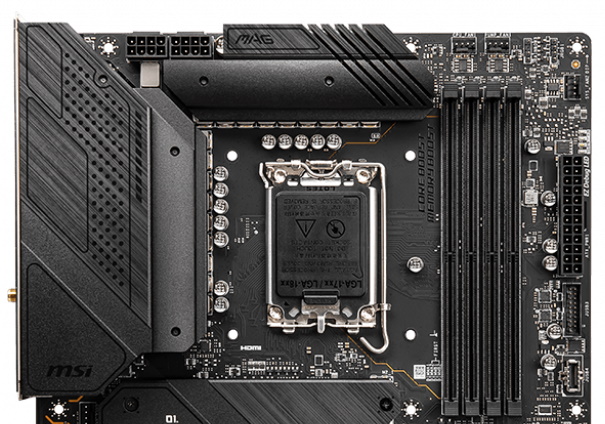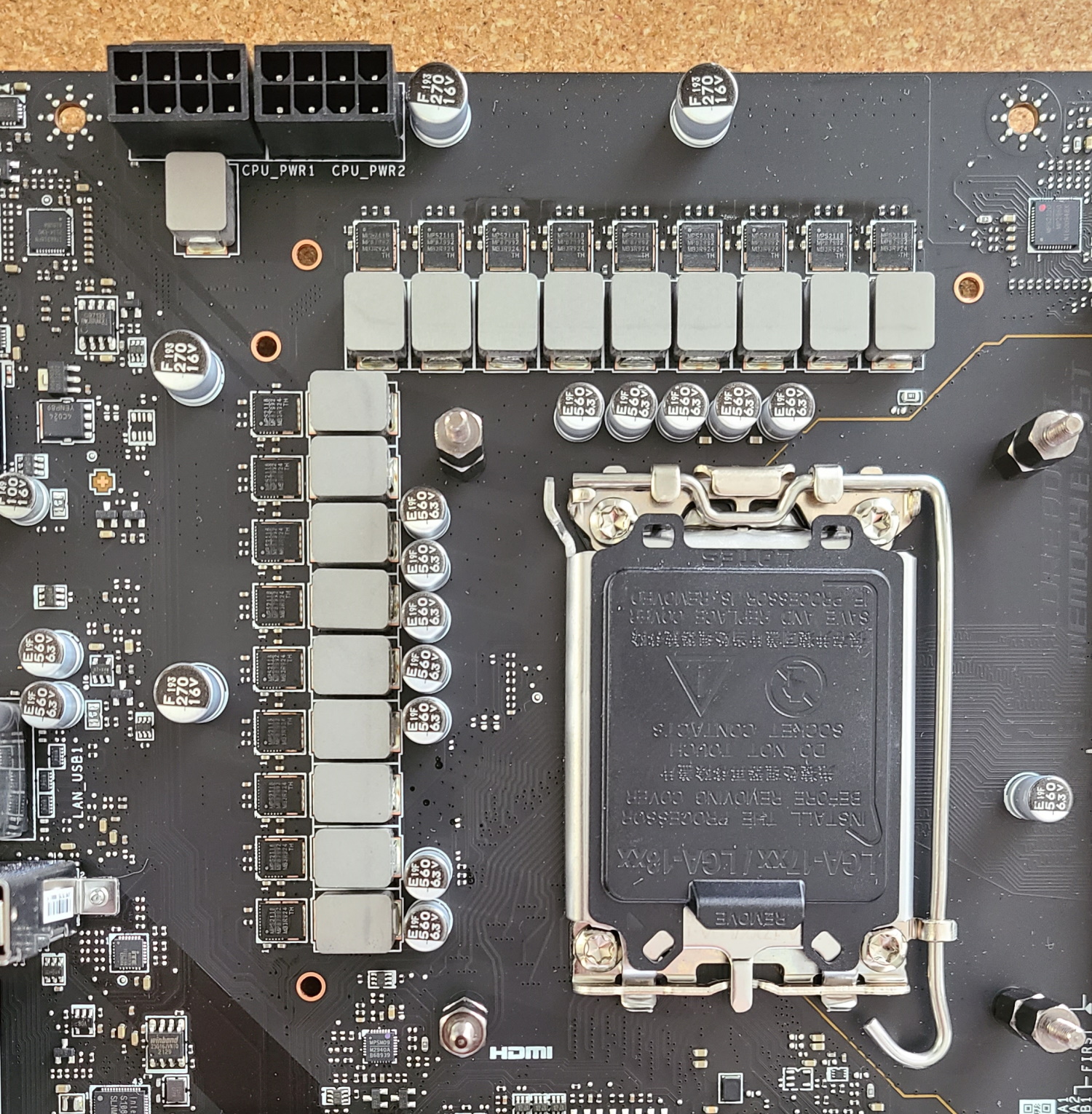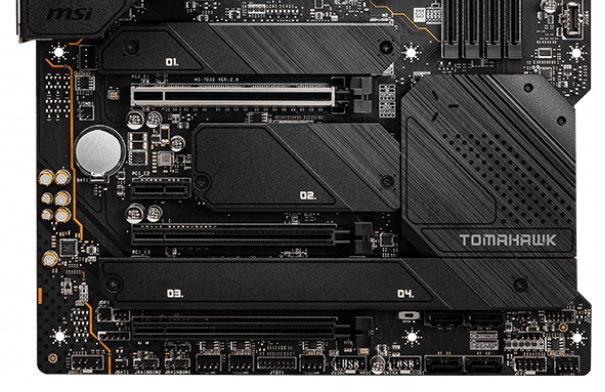Tom's Hardware Verdict
At $309, the MSI MAG Z690 Tomahawk WIFI includes four M.2 sockets, a capable VRM, 2.5 GbE with Wi-Fi 6 and an updated, all-black, RGB-free aesthetic. If you’re in the market for a lower-priced Alder Lake board and don’t require integrated RGB lighting, this is an excellent option to build your system around.
Pros
- +
+ Four M.2 sockets
- +
+ All-black aesthetic
- +
+ Price
Cons
- -
No integrated RGB
- -
Could use more USB ports
Why you can trust Tom's Hardware
Although MSI’s MAG Z690 Tomahawk WIFI is priced fairly low (yes, $310 is low for a flagship-chipset board these days), the motherboard doesn’t disappoint on features. It comes with four M.2 sockets, integrated WI-Fi 6, the latest-generation audio codec, and a stealthy appearance that’s refreshing after years of RGB overload.
Compared to the previous generation Z590 Tomahawk, you get PCIe 5.0 support, an additional M.2 socket, updated power delivery, and a more premium appearance that skips integrated RGB lighting. The best part about the Tomahawk is the price. At $309.99, it’s on the ‘reasonable’ side of Z690 motherboards, and its price only increased about $30 over the last generation Tomahawk. Most (if not all) motherboard pricing has increased over the last couple of years, due to a combination of shortages and the more demanding needs of faster PCIe lanes. So to see such a meager increase from one generation to the next is refreshing.
Performance on the Z690 Tomahawk ended up average overall among the other boards we tested. While all tests were very close in either direction, the Procyon tests showed the most significant departure from average, matching the slower DDR4 boards more closely than their DDR5 counterparts. Gaming results were on par, if not marginally faster, than the rest so we’re in good shape there.
During testing, the only complaint I had with the MAG Z690 Tomahawk WIFI was that the board used too much voltage for stock operation, which caused minor thermal throttling during a stress test. Read on for more details covering the features, overclocking, and our takeaways from testing and use. First though, here’s a complete list of the MAG Z690 Tomhawk’s specs, direct from MSI.
Specifications - MSI MAG Z690 Tomahawk WIFI
| Socket | LGA1700 |
| Chipset | Z690 |
| Form Factor | ATX |
| Voltage Regulator | 18-Phase (16, 70A MOSFETs for Vcore) |
| Video Ports | (1) HDMI (v2.1) |
| Row 5 - Cell 0 | (1) DisplayPort (v1.4) |
| USB Ports | (1) USB 3.2 Gen 2x2 Type-C (20 Gbps) |
| Row 7 - Cell 0 | (3) USB 3.2 Gen 2 (10 Gbps) |
| Row 8 - Cell 0 | (2) USB 3.2 Gen 1 (5 Gbps) |
| Row 9 - Cell 0 | (2) USB 2.0 (480 Mbps) |
| Network Jacks | (1) 2.5 GbE |
| Audio Jacks | (5) Analog + SPDIF |
| Legacy Ports/Jacks | ✗ |
| PCIe x16 | (1) PCIe v5.0 (x16) |
| Row 14 - Cell 0 | (1) PCIe v3.0 (x4) |
| Row 15 - Cell 0 | (1) PCIe v3.0 (x1) |
| PCIe x8 | Row 16 - Cell 1 |
| PCIe x4 | Row 17 - Cell 1 |
| PCIe x1 | (1) PCIe v3.0 (x1) |
| CrossFire/SLI | AMD Quad Fire/2-Way CrossFire |
| DIMM slots | (4) DDR5 6400+(OC), 128GB Capacity |
| Row 21 - Cell 0 | 1DPC 1R Max speed up to 6400+ MHz |
| Row 22 - Cell 0 | 1DPC 2R Max speed up to 5400+ MHz |
| Row 23 - Cell 0 | 2DPC 1R Max speed up to 4000+ MHz |
| Row 24 - Cell 0 | 2DPC 2R Max speed up to 4000+ MHz |
| M.2 slots | (1) PCIe 4.0 x4 (64 Gbps) / PCIe (up to 110mm) |
| Row 26 - Cell 0 | (1) PCIe 4.0 x4 (64 Gbps) / PCIe (up to 80mm) |
| Row 27 - Cell 0 | (1) PCIe 3.0 x4 (32 Gbps) / PCIe + SATA (up to 80mm) |
| Row 28 - Cell 0 | (1) PCIe 4.0 x4 (64 Gbps) / PCIe + SATA (up to 80mm) |
| Row 29 - Cell 0 | Supports RAID 0/1/5 |
| U.2 Ports | ✗ |
| SATA Ports | (6) SATA3 6 Gbps (Supports RAID0/1/5/10) |
| USB Headers | (1) USB v3.2 Gen 2, Type-C (10 Gbps) |
| Row 33 - Cell 0 | (1) USB v3.2 Gen 1 (5 Gbps) |
| Row 34 - Cell 0 | (2) USB v2.0 (480 Mbps) |
| Fan/Pump Headers | (8) 4-Pin (CPU, Water pump, System Fans) |
| RGB Headers | (3) aRGB (3-pin) |
| Row 37 - Cell 0 | (1) RGB (4-pin) |
| Diagnostics Panel | EZ Debug LED (4 LEDs) |
| Internal Button/Switch | LED enable/disable switch |
| SATA Controllers | ✗ |
| Ethernet Controller(s) | (1) Intel I225-V (2.5 Gbps) |
| Wi-Fi / Bluetooth | Intel AX201 Wi-Fi 6E (2x2 ax, MU-MIMO, 2.4/5/6 GHz, 160 MHz, BT 5.2) |
| USB Controllers | Genesysloogic GL850G |
| HD Audio Codec | Realtek ALC4080 |
| DDL/DTS Connect | ✗ / ✗ |
| Warranty | 3 Years |
Inside the box, along with the MSI MAG Z690 Tomahawk WIFI, is the accessory stack designed to get you started with the basics (think SATA cables, Wi-Fi antenna and a driver disk) without another a trip to the store. We have all of that, plus the driver disk is on a USB stick. Below is a complete list of the included extras.
- USB drive (drivers)
- Cleaning brush
- Wi-Fi antenna
- Case badge
- User manual
- Quick installation guide
- MAG and Cable stickers
- M.2 screws/standoff sets
- EZ M.2 clip
- Screwdrivers
- EZ Front panel cable
- (2) SATA cables
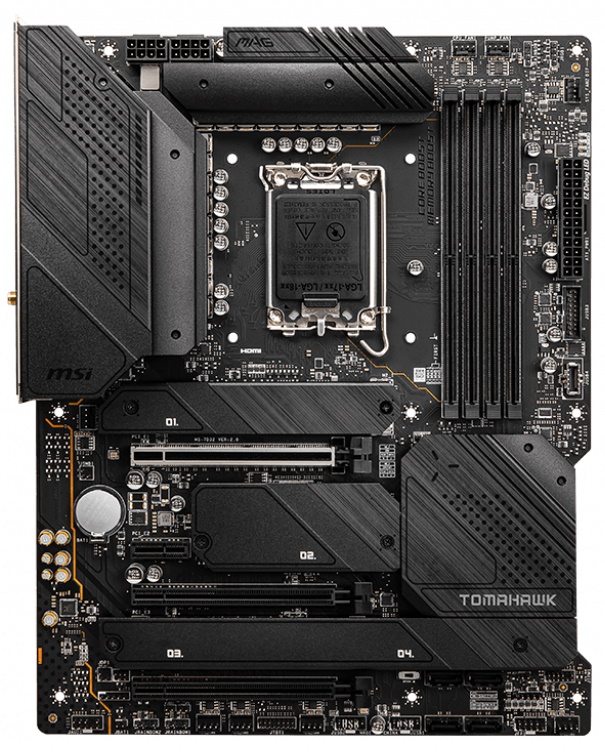

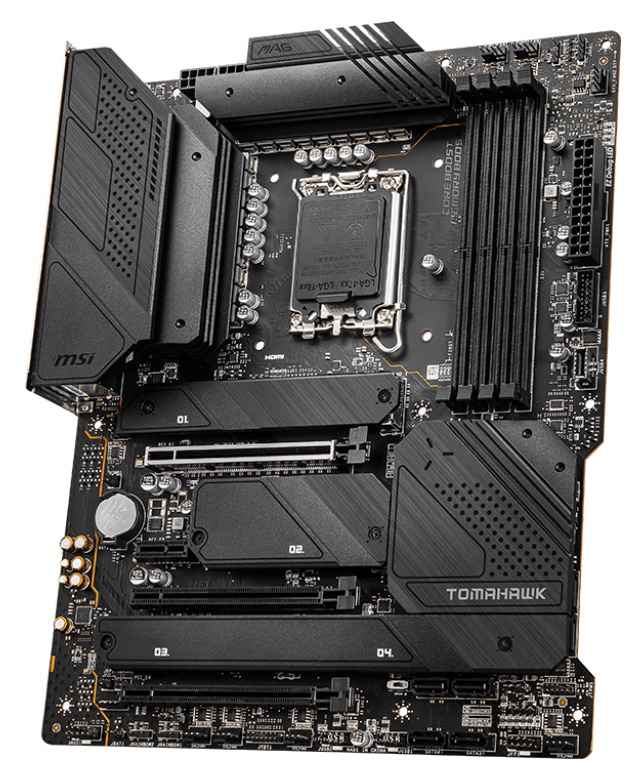
Looking at the Z690 Tomahawk WIFI itself on our test bench, we get a better view of the jet-black 6-layer PCB and heatsinks. The Tomahawk still keeps the military theme, with the heatsinks looking like panels on an army vehicle. You’ll find minimal branding, including the Tomahawk name in white on the chipset, while the MSI and MAG names hide on the VRM heatsink in black.
If you’re looking for integrated RGB lighting from the motherboard, look elsewhere as the Tomahawk WIFI does without. All lighting has to come from external RGB strips, but you do get four headers for that purpose on the board. In all, this board doesn’t jump out at you as a showpiece, but you don’t need to hide it in a windowless chassis either.
Get Tom's Hardware's best news and in-depth reviews, straight to your inbox.
Focusing on the top half of the board, we’ll start on the left side and look at the large metal VRM heatsinks first. There is plenty of mass and surface area here to keep the VRMs below running within spec. The heatsinks aren’t connected to each other, but proved they could handle whatever we threw at them using the Intel Core i9-12900K processor. The two 8-pin EPS connectors (one required), located between the VRM heatsinks, deliver power to the CPU.
Shifting focus toward the right, we move past the socket area and run into the four double-side locking DRAM slots. These unreinforced slots support up to 128GB of DDR5 RAM (there is a DDR4 version of this board as well) with speeds listed up to DDR5 6400+ MHz. The more RAM sticks and higher capacity used, the lower peak value. For example, a two DIMM per channel configuration lists up to DDR5 4000. As always, your mileage may vary as to what you can achieve as what’s achievable depends on the memory kit in use and the processor’s memory controller.
Just above the DRAM slots are the first two (of eight) 4-pin fan headers. The CPU_FAN1 and PUMP_FAN1 located here default to PWM mode and output up to 2A/24W and 3A/36W. The remainder of the fans (SYS_FAN1-6) start in DC mode and provide up to 1A/12W. Overall, there are plenty of fan headers with plenty of power behind them to drive your chassis fans and water pump without worry.
To the right of the fan headers are the first two (of four) RGB headers. There are three 3-pin ARGB headers and one 4-pin RGB header. It’s nice to see plenty of RGB options, despite the lack of lighting on the board itself.
We spy a SYS_FAN header along the right edge, the EZDebug LED, 24-pin ATX connector, a USB 3.2 Gen1 header, and a front-panel USB 3.2 Gen 2 Type-C header. Everything is in its place here.
Focusing on the VRM, MSI uses an 18-phase configuration with 16 phases dedicated to Vcore. Power is fed through the 8-pin EPS connectors and onto a Monolithic Power Systems MP2120 PWM controller. Details are scarce on the controller itself. However, MSI states this is a duet power design (two MOSFETs get fed per channel without a phase doubler) that feeds 70A Monolithic Power Systems DrMOS MOSFETs. The 1,120A available for the processor is enough for stock operation and some overclocking.
Moving down to the bottom half of the board, we see (among other things) the audio section, all four M.2 sockets covered with MSI M.2 Shield Frozr cooling, and the PCIe Steel armor that reinforces the PCIe slot. Starting with the audio on the left, we see everything the Z690 Tomahawk offers, because there’s no should or faraday cage. You can see the premium Realtek ALC4080 audio chip, is covered by a shroud or faraday cage and several Chemicon-branded audio caps. Overall, this is a quality audio implementation, especially at this price.
Moving to the PCIe slots in the middle of the board, there are four total, three full-length, plus a closed-back x1 size slot. The primary video card slot (top) uses reinforcement (Steel Armor), connects via the CPU and supports PCIe 5.0 x16 speeds. The two other full-length slots source their lanes from the chipset and run PCIe 3.0 x4 and x1, respectively. The small x1 slot is connected through the chipset and runs PCIe 3.0 as well. Be warned that the x1 slot could be covered and rendered unusable if a large 2-plus slot size graphics card is used.
On the M.2 front, the Z690 Tomahawk has four total slots, all of which are covered by MSI’s M.2 Shield Frozr heatsinks. The top two sockets (M2_1 and M2_2) run PCIe 4.0 x4 (64 Gbps) speeds with PCIe-based drives up to 110mm (80mm for M2_2). M2_1 sources its lanes from the CPU while the second uses the chipset. The third and fourth slots (M2_3 and M2_4) support PCIe 4.0 x4 (64 Gbps) and SATA-based modules up to 80mm.
Just to the right, hidden under the chipset heatsink, are two of the six SATA ports. The other four ports are oriented vertically and on the bottom edge of the board. MSI doesn’t list any lane sharing, and according to the block diagram in the user manual the M.2 sockets and SATA ports don’t share anything. In other words, you’re able to run any combination of SATA drives and M.2-based storage without losing a port or socket.
Several headers run across the bottom, including USB and SATA ports and RGB connections – nothing out of the ordinary. Here’s the complete list, from left to right:
- Front panel audio
- 3-pin ARGB header
- 4-pin RGB header
- (2) 4-pin fan headers
- Thunderbolt header
- 4-pin fan header
- (2) USB 2.0 headers
- (4) SATA ports
- RGB enable/disable switch
- TPM header
- 4-pin fan header
- Front panel header
Looking at the integrated rear IO, we see the black theme continues here as well, along with grey writing on the ports. There are eight USB ports in total, seven Type-A (3x USB 3.2 Gen2, 2x USB 3.2 Gen1, and 2x USB 2.0) and a single USB 3.2 Gen 2x2 Type-C port. The seven Type-A ports may be too few for some users. On the left side are two video ports, HDMI and Displayport, for use with an integrated graphics processor. There’s also an Intel I225-V GbE port, connections for the Wi-Fi antenna, and a five plug (plus SPDIF) audio stack.
MORE: Best Motherboards
MORE: How To Choose A Motherboard
MORE: All Motherboard Content

Joe Shields is a staff writer at Tom’s Hardware. He reviews motherboards and PC components.
-
greenreaper Been looking at this myself, but the DDR4 version, since DDR5 availability and price isn't quite there yet - especially if you're looking for a reasonable latency. Note that at least on the DDR4 version, one of the M.2 slots appears to be only PCIe 3.x, not 4.x. But hey, if you're planning to fill them all, either you've got enough money to buy a more expensive motherboard, or you can put the slowest one in there later on.Reply -
singemagique Reply
So much yes. I fracking hate RGB on everything. I'm not even particularly fond of needlessly decorative heat spreaders on RAM.OriginFree said:Mistake report:
The "No integrated RGB" should be in the Pro column.
